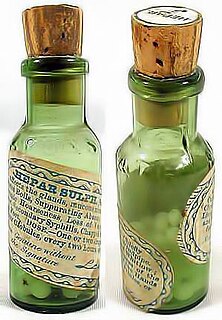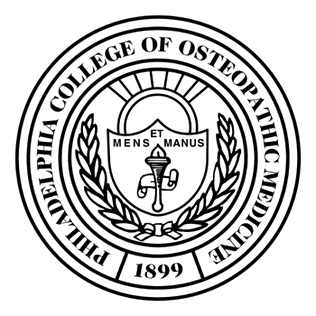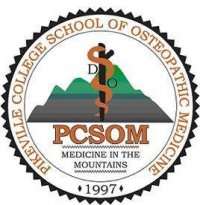Related Research Articles

A physician, medical practitioner, medical doctor, or simply doctor, is a professional who practices medicine, which is concerned with promoting, maintaining or restoring health through the study, diagnosis, prognosis and treatment of disease, injury, and other physical and mental impairments. Physicians may focus their practice on certain disease categories, types of patients, and methods of treatment—known as specialities—or they may assume responsibility for the provision of continuing and comprehensive medical care to individuals, families, and communities—known as general practice. Medical practice properly requires both a detailed knowledge of the academic disciplines, such as anatomy and physiology, underlying diseases and their treatment—the science of medicine—and also a decent competence in its applied practice—the art or craft of medicine.

Naturopathy, or naturopathic medicine, is a form of alternative medicine. It employs an array of pseudoscientific practices branded as "natural", "non-invasive", or promoting "self-healing". The practices of naturopaths, the practitioners of naturopathic medicine, vary widely and are difficult to generalize. Treatments range from outright quackery, like homeopathy, to widely accepted practices like psychotherapy. The ideology and methods of naturopathy are based on vitalism and folk medicine rather than evidence-based medicine (EBM), although some practitioners may use techniques supported by EBM. Naturopathic practitioners commonly recommend against following modern medical practices, including but not limited to medical testing, drugs, vaccinations, and surgery. Instead, naturopathic practice relies on unscientific notions, often leading naturopaths to diagnoses and treatments that have no factual merit.

Osteopathy is a type of alternative medicine that emphasizes physical manipulation of the body's muscle tissue and bones. Practitioners of osteopathy are referred to as osteopaths. Its name derives from Ancient Greek "bone" and "pain, suffering".
Osteopathic medicine is a branch of the medical profession in the United States that promotes the practice of allopathic medicine with a set of philosophy and principles set by its earlier form, osteopathy. Osteopathic physicians (DOs) are licensed to practice medicine and surgery in all 50 US states. Only graduates of American osteopathic medical colleges may practice the full scope of medicine and surgery generally considered to be medicine by the general public; US DO graduates have historically applied for medical licensure in 87 countries outside of the United States, 85 of which provided them with the full scope of medical and surgical practice. The field is distinct from osteopathic practices offered in nations outside of the U.S., whose practitioners are generally not considered part of core medical staff nor of medicine itself. The other major branch of medicine in the United States is referred to by practitioners of osteopathic medicine as allopathic medicine.
A podiatrist ( poh-dye-eh-trist) or podiatric physician and surgeon is a medical professional devoted to the treatment of disorders of the foot, ankle, and related structures of the leg. The term originated in North America but has now become the accepted term in the English-speaking world for all practitioners of podiatric medicine. The word chiropodist was previously used in the United States, but it is now regarded as antiquated.
A physician assistant or physician associate (PA) is a type of mid-level health care provider. PAs may diagnose illnesses, develop and manage treatment plans, prescribe medications, and may serve as a principal healthcare provider. PAs are required in nearly all states to have a direct agreement with a physician for supervision and collaboration.

Podiatry or podiatric medicine is a branch of medicine devoted to the study, diagnosis, and medical and surgical treatment of disorders of the foot, ankle, and lower extremity. The term podiatry came into use in the early 20th century in the United States and is now used worldwide, including in countries such as the United Kingdom, Australia, and Canada.
The University of North Texas Health Science Center (UNTHSC) is a public medical school in Fort Worth, Texas. It is a graduate-level institution of the University of North Texas System. Established in 1970, UNT Health Science Center consists of five colleges with a total enrollment of 2,243 graduate students (2014–15). The institution offers degrees in both osteopathic and allopathic medicine, public health, pharmacy, physical therapy, physician assistant studies, and biomedical sciences. The World Directory of Medical Schools lists both the MD and DO granting institutes as US medical school along with other accredited US MD and DO programs.

The American Osteopathic Association (AOA) is the representative member organization for the more than 145,000 osteopathic medical doctors (D.O.s) and osteopathic medical students in the United States. The AOA is headquartered in Chicago, Illinois, and is involved in post-graduate training for osteopathic physicians. Beginning in 2015, it began accrediting post-graduate education as a committee within ACGME, creating a unified accreditation system for all DOs and MDs in the United States. The organization promotes public health, encourages academic scientific research, serves as the primary certifying body for D.O.s overseeing 18 certifying boards, and is the accrediting agency for osteopathic medical schools through its Commission on Osteopathic College Accreditation. As of October 2015, the AOA no longer owns the Healthcare Facilities Accreditation Program (HFAP), which accredited hospitals and other health care facilities.

Philadelphia College of Osteopathic Medicine (PCOM) is a private medical school with its main campus in Philadelphia, Pennsylvania, and additional locations in Suwanee, Georgia and Moultrie, Georgia.
Medical education in the United States includes educational activities involved in the education and training of physicians in the United States, from entry-level training through to continuing education of qualified specialists.
Medical education in Philippines is principally offered and developed by accredited and government recognized medical schools in the country.
Most physicians in the United States hold either the Doctor of Medicine degree (MD) or the Doctor of Osteopathic Medicine degree (DO). Institutions awarding the MD are accredited by the Liaison Committee on Medical Education (LCME). Institutions awarding the DO are accredited by the Commission on Osteopathic College Accreditation (COCA). The World Directory of Medical Schools lists both LCME accredited MD programs and COCA accredited DO programs as US medical schools. Foreign-trained osteopaths do not hold DO degrees and are not recognized as physicians in the United States or in other jurisdictions.

A.T. Still University (ATSU) is a private medical school based in Kirksville, Missouri, with a second campus in Arizona. It is accredited by the Higher Learning Commission.The World Directory of Medical Schools lists the medical school as a US medical school along with other accredited US MD and DO programs. ATSU includes two campuses on 200 acres with six schools and colleges. ATSU offers degrees in medicine, athletic training, audiology, dentistry, occupational therapy, and physical therapy. Founded in 1892 by Dr. Andrew Taylor Still, it was the world's first osteopathic medical school. In 1995, a new campus opened in Arizona.
Doctor of Osteopathic Medicine is a medical degree offered by medical schools in the United States. A DO graduate may become licensed as a physician. DOs have full medical and surgical practicing rights in all 50 US states. As of 2021, there were more than 168,000 osteopathic physicians and medical students in DO programs across the United States.
The Canadian Osteopathic Association (COA) is a professional association of osteopathic physicians in Canada. The COA has partnered with Michigan State University College of Osteopathic Medicine to increase the number of osteopathic physicians practising in Canada.

The University of Pikeville - Kentucky College of Osteopathic Medicine (UP-KYCOM) is a private, non-profit, medical school located in Pikeville, in the U.S. state of Kentucky. UP-KYCOM was established in 1997, grants the Doctor of Osteopathic Medicine degree, and is an academic division of the University of Pikeville. The college is accredited by the Commission on Osteopathic College Accreditation (COCA) and by the Commission on Colleges of the Southern Association of Colleges and Schools.

The College of Osteopathic Medicine of the Pacific (COMP) is a private, non-profit medical school for osteopathic medicine located in downtown Pomona, in the U.S. state of California. The college opened in 1977 as the only osteopathic medical school west of the Rocky Mountains. COMP was the founding program of Western University of Health Sciences (WesternU), which now has 8 colleges in addition to COMP, each offering professional degrees in various fields of healthcare. COMP has a single 4-year program, conferring the Doctor of Osteopathic Medicine (D.O.) degree. Graduates are eligible to practice medicine in all 50 states and more than 85 countries.
The College of Physicians and Surgeons of British Columbia is a regulatory college which regulates the practice of medicine in British Columbia. The primary function of the College is to ensure that physicians are qualified, competent and fit to practise medicine. The College administers processes for responding to complaints from patients and for taking action if a physician is practising in a manner that is incompetent, unethical or illegal.

Physicians and surgeons play an important role in the provision of health care in Canada. They are responsible for the promotion, maintenance, and restoration of health through the study, diagnosis, prognosis, and treatment of disease, injury, and other physical and mental impairments. As Canadian medical schools solely offer the Doctor of Medicine (M.D.) or Doctor of Medicine and Master of Surgery degrees, these represent the degrees held by the vast majority of physicians and surgeons in Canada, though some have a Doctor of Osteopathic Medicine (D.O.) from the United States or Bachelor of Medicine, Bachelor of Surgery from Europe.
References
- ↑ "Ontario Medicine Act – Restricted Titles, Section 9". Province of Ontario, Canada. Retrieved 13 November 2011.
- ↑ "British Columbia Medical Practitioners Act, Section 40 Registration of Osteopaths". 1 June 2009. Retrieved 13 November 2011.
- ↑ "Alberta Medical Profession Act, Sections 3 and 18" . Retrieved 13 November 2011.
- ↑ "MSUCOM pilot program targets Canadian students for training". The DO. Archived from the original on 2014-04-24. Retrieved 3 May 2014.
- ↑ "Who Provides Osteopathy?". Ontario Association of Osteopathic Manual Practitioners. Archived from the original on 2014-04-24. Retrieved 28 April 2014.
- ↑ "Archived copy". Archived from the original on 2014-02-14. Retrieved 2014-04-14.CS1 maint: archived copy as title (link)
- ↑ "Canadian Osteopathic Practice (.doc)". Archived from the original on 2011-07-06. Retrieved 2009-02-19.
- ↑ Ontario Medicine Act – Restricted Titles, Section 9
- ↑ College of Physicians and Surgeons of Ontario Doctor of Osteopathy Registration Policy Statement
- ↑ "Bylaws" (PDF). College of Physicians and Surgeons of British Columbia. Archived from the original (PDF) on 10 August 2011. Retrieved 29 August 2012.
- ↑ "Alberta Medical Profession Act: Sections 3 and 18". Federation of Law Societies of Canada. Retrieved 29 August 2012.
- ↑ Use of Titles Albert Health Professions Act Schedule 21
- ↑ "AOA International Licensure Summary" (PDF). American Osteopathic Association. April 2013.[ permanent dead link ]
- ↑ "Welcome!". Canadian Osteopathic Medical Student Association. 2012. Archived from the original on 1 November 2012. Retrieved 12 August 2012.